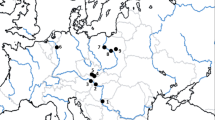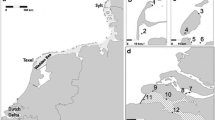Abstract
The introduction of American shad from the Atlantic to the Pacific coast of North America in the late 1800’s and the subsequent population expansion in the 1980’s resulted in the amplification of Ichthyophonus sp., a Mesomycetozoean parasite of wild marine fishes. Sequence analysis of the ribosomal DNA gene complex (small subunit and internal transcribed spacer regions) and Ichthyophonus epidemiological characteristics indicate a low probability that Ichthyophonus was co-introduced with American shad from the Atlantic; rather, Ichthyophonus was likely endemic to marine areas of the Pacific region and amplified by the expanding population of a highly susceptible host species. The migratory life history of shad resulted in the transport of amplified Ichthyophonus from its endemic region in the NE Pacific to the Columbia River watershed. An Ichthyophonus epizootic occurred among American shad in the Columbia River during 2007, when infection prevalence was 72%, and 57% of the infections were scored as moderate or heavy intensities. The epizootic occurred near the record peak of shad biomass in the Columbia River, and corresponded to an influx of 1,595 mt of infected shad tissues into the Columbia River. A high potential for parasite spillback and the establishment of a freshwater Ichthyophonus life cycle in the Columbia River results from currently elevated infection pressures, broad host range, plasticity in Ichthyophonus life history stages, and precedents for establishment of the parasite in other freshwater systems. The results raise questions regarding the risk for sympatric salmonids and the role of Ichthyophonus as a population-limiting factor affecting American shad in the Columbia River.



Similar content being viewed by others
References
AFS–FHS (AFS–Fish Health Section) (2007) FHS blue book: Suggested procedures for the detection and identification of certain finfish and shellfish pathogens, 2007 edition. AFS–FHS, Bethesda, MD
Alderman DJ (1982) Fungal diseases of aquatic animals. In: Roberts RJ (ed) Microbial diseases of fish. Academic Press, London, pp 189–242
Arkush KD, Mendonca HL, McBride AM, Yun S, McDowell TS, Hedrick RP (2006) Effects of temperature on infectivity and commercial freezing on survival of the North American strain of viral hemorrhagic septicemia virus. Dis Aquat Org 69:145–151
Bruce A, Norman FI (2000) Changes in the diet of the Australian gannet (Morus serrator) in response to the 1998 mortality of pilchards (Sardinops sagax). Mar Freshw Res 51:349–353
Columbia River Data Access in Real Time (DART). http://www.cbr.washington.edu/dart/
Criscione CD, Watral V, Whipps CM, Blouin MS, Jones SRM, Kent ML (2002) Ribosomal DNA sequences indicate isolated populations of Ichthyophonus hoferi in geographic sympatry in the north-eastern Pacific Ocean. J Fish Dis 25:575–582
Cunningham AA (1996) Disease risks of wildlife translocations. Cons Biol 10:349–353
Cunningham AA, Daszak P, Rodríguez JP (2003) Pathogen pollution: defining a parasitological threat to biodiversity conservation. J Parasitol 89:S78–S83
Dann P, Norman FI, Cullen JM, Neira FJ, Chiaradia A (2000) Mortality and breeding failure of the little penguins, Eudyptula minor, in Victoria, 1995–96, following a widespread mortality of pilchard, Sardinops sagax. Mar Freshw Res 51:355–362
Daszak P, Cunningham AA, Hyatt AD (2003) Infectious disease and amphibian population declines. Divers Distrib 9:141–150
Erickson JD (1965) Report on the problem of Ichthyosporidium in rainbow trout. Prog Fish Cult 27:179–184
Gaughan DJ, Mitchell RW, Blight SJ (2000) Impact of mortality, possibly due to herpesvirus, on pilchard Sardinops sagax stocks along the south coast of Western Auatralia in 1998–99. Mar Freshw Res 51:601–612
Griffin DA, Thompson PA, Bax NJ, Bradford RW, Hallegraeff GM (1997) The 1995 mass mortality of pilchard: no role found for physical or biological oceanographic factors in Australia. Mar Freshw Res 48:27–42
Halos D, Hart SA, Hershberger PK, Kocan RM (2005) Ichthyophonus in Puget Sound rockfish from the San Juan Islands Archipelago and Puget Sound, Washington, USA. J Aquat Anim Health 17:222–227
Haskell CA, Tiffan KF, Rondorf DW (2006) Food Habits of juvenile American shad and dynamics of zooplankton in the lower Columbia River. NW Sci 80:47–64
Hershberger PK, Kocan RM, Elder NE, Meyers TR, Winton JR (1999) Epizootiology of viral hemorrhagic septicemia virus in herring from the closed pound spawn-on-kelp fishery. Dis Aquat Org 37:23–31
Hershberger PK, Stick K, Bui B, Carroll C, Fall B, Mork C, Perry JA, Sweeny E, Wittouck J, Winton J, Kocan R (2002) Incidence of Ichthyophonus hoferi in Puget Sound fishes and its increase with age of Pacific herring. 2002. J Aquat Anim Health 14:50–56
Hershberger PK, Pacheco CA, Gregg JL, Purcell M, LaPatra SE (2008) Differential survival of Ichthyophonus isolates indicates parasite adaptation to its host environment. J Parasitol 94:1055–1059
Hochachka WM, Dhondt AA (2000) Density-dependent decline of host abundance resulting from a new infectious disease. Proc Nat Acad Sci USA 97:5303–5306
Hudson P, Greenman J (1998) Competition mediated by parasites: biological and theoretical progress. Trends Ecol Evol 13:387–390
Hudson PJ, Dobson AP, Newborn D (1998) Prevention of parasite cycles by parasite removal. Science 282:2256–2258
Hyatt AD, Hine PM, Jones JB, Whittington RJ, Kearns C, Wise TG, Crane MS, Williams LM (1997) Epizootic mortality in the pilchard Sardinops sagax neoplichardus in Austalia and New Zealand in 1995. II. Identification of a herpesvirus within the gill epithelium. Dis Aquat Org 28:17–29
Jones SRM, Dawe SC (2002) Ichthyophonus hoferi Plehn & Mulsow in British Columbia stocks of Pacific herring, Clupea pallasi Valenciennes, and its infectivity to Chinook salmon, Oncorhynchus tshawytscha (Walbaum). J Fish Dis 25:414–421
Jones JB, Hyatt AD, Hine PM, Whittington RJ, Griffin DA, Bax NJ (1997) Special topic review: Australian pilchard mortalities. W J Microb Biotech 13:383–392
Kelly DW, Patterson RA, Townsend CR, Poulin R, Tompkins DM (2009) Parasite spillback: a neglected concept in invasion ecology? Ecology 90:2047–2056
Kent ML, Watral V, Dawe SC, Reno P, Heidel JR, Jones SRM (2001) Ichthyophonus and Mycobacterium-like bacterial infections in commercially-important rockfish, Sebastes spp. in the eastern North Pacific Ocean. J Fish Dis 24:427–431
Kocan RM, Hershberger P, Mehl T, Elder N, Bradley M, Wildermuth D, Stick K (1999) Pathogenicity of Ichthyophonus hoferi for laboratory-reared Pacific herring Clupea pallasi and its early appearance in wild Puget Sound herring. Dis Aquat Org 35:23–29
Kocan RM, Hershberger PK, Winton J (2004) Ichthyophoniasis: an emerging disease of chinook salmon (Oncorhynchus tshawytscha) in the Yukon River. J Aquat Anim Health 16:58–72
Kocan R, LaPatra S, Gregg J, Winton J, Hershberger P (2006) Ichthyophonus-induced cardiac damage: a mechanism for reduced swimming stamina in rainbow trout. J Fish Dis 29:521–527
Kocan RM, Gregg JL, Hershberger PK. (in press). Release of infectious cells from the skin of Pacific herring (Clupea pallasii) with ichthyophoniasis. J Parasitol
Kowarik I (1995) Time lags in biological invasions with regard to the success and failure of an alien species. In: Pysek P, Prach K, Rejmanek M, Wade M (eds) Plant invasions—general aspects and special problems. SPB Acaemic, Amsterdam, The Netherlands, pp 15–38
Krkošek M, Ford JS, Morton A, Lele S, Myers RA, Lewis MA (2007) Declining wild salmon populations in relation to parasites from farm salmon. Science 318:1772–1775
Lafferty KD, Gerber LR (2002) Good medicine for conservation biology: the intersection of epidemiology and conservation theory. Cons Biol 16:593–604
Laurenson K, Sillero-Zubiri C, Thompson H, Shiferaw F, Thirgood S, Malcolm J (1998) Disease as a threat to endangered species: Ethiopian wolves, domestic dogs, and canine pathogens. Anim Cons 1:273–280
Marty GD, Frieberg EF, Meyers TR, Wilcock J, Farver TB, Hinton DE (1998) Viral hemorrhagic septicemia virus, Ichthyophonus hoferi, and other causes of morbidity in Pacific herring Clupea pallasi spawning in Prince William Sound, Alaska, USA. Dis Aquat Org 32:15–40
McVicar AH (1999) Ichthyophonus and related organisms. In: Woo PTK, Bruno DW (eds) Fish diseases and disorders. Viral, bacterial and fungal infections, vol 3. CABI Publishing, New York, pp 661–687
Moyle PB, Li HW, Barton BA (1986) The Frankenstein effect: impact of introduced fishes on native fishes in North America. In: Stroud RH (ed) Fish culture in fisheries management. Chapman and Hall, New York, pp 415–426
Okamoto N, Nakase K, Suzuki H, Nakai Y, Fujii K, Sano T (1985) Life history and morphology of Ichthyophonus hoferi in vitro. Fish Path 20:273–285
Olson R (1986) Ichthyophonus infection in a Pacific staghorn sculpin (Leptocottus armatus) from Oregon. J Wildl Dis 22:566–569
Petersen JH, Hinrichsen RA, Gadomski DM, Feil DH, Rondorf DW (2003) American shad in the Columbia River. Am Fish Soc Symp 35:141–155
Picco AM, Collins JP (2008) Amphibian commerce as a likely source of pathogen pollution. Cons Biol 22:1582–1589
Power AG, Mitchell CE (2004) Pathogen spillover in disease epidemics. Am Nat 164:S79–S89
Rasmussen C, Purcell MK, Gregg JL, LaPatra SE, Winton JR, Hershberger PK (2010) Sequencing of the internal transcribed spacer (ITS) region reveals a novel clade of Ichthyophonus sp. from rainbow trout. Dis Aquat Org 89:179–183
Rucker RR, Gustafson PV (1953) An epizootic among rainbow trout. Prog Fish Cult 15:179–181
Ruiz GM, Rawlings TK, Dobbs FC, Drake LA, Mullady T, Huq A, Colwell RR (2000) Global spread of microorganisms by ships. Nature 408:49–50
Rupprecht CE, Smith JS, Fekadu M, Childs JE (1995) The ascension of wildlife rabies—a cause for public health concern or intervention. Emerg Infect Dis 1:107–114
Sakai AK, Allendorf FW, Holt JS, Lodge DM, Molofsky J, With KA, Baughman S, Cabin RJ, Cohen JE, Ellstrand NC, McCauley DE, O’Neil P, Parker IM, Thompson JN, Weller SG (2001) The population biology of invasive species. Ann Rev Ecol Syst 32:305–332
Simberloff D, Gibbons L (2004) Now you see them, now you don’t—population crashes of established introduced species. Biol Inv 6:161–172
Sindermann C (1990) Chapter 4. Fungi. In: Principle diseases of marine fish and shellfish, 2 edn, vol 1, Diseases of Marine Fish. Academic Press, New York, pp 57–78
Smith HM (1886) A review of the history and results of the attempts to acclimatize fish and other water animals in the Pacific states. US Fish Com Bull 15:379–472
Stewart JE (1991) Introduction as factors in diseases of fish and aquatic invertebrates. Can J Fish Aquat Sci 48(Suppl. 1):110–117
Uno M (1990) Effects of seawater acclimation on juvenile salmonids infected with Tetraonchus (Monogenea) and Ichthyophonus (Phycomycetes). Fish Path 25:15–19
Ward TM, Hoedt F, McLeay L, Dimmlich WF, Kinlochv M, Jackson G, McGarvey R, Rogers PJ, Jones K (2001) Effects of the 1995 and 1998 mass mortality events on the spawning biomass of sardine, Sardinops sagax, in South Austarlian waters. ICES J Mar Sci 58:865–875
Wyatt KB, Campos PF, Gilbert MTP, Kolokotronis SO, Hynes WH, Desalle R, Daszak P, MacPhee RDE, Greenwood AD (2008) Historical mammal extinction on Christmas Island (Indian Ocean) correlates with introduced infectious disease. PLOS One 3:1–9
Washington Department of Fish and Wildlife. http://wdfw.wa.gov/outreach/fishing/shad/shad.htm
Acknowledgments
Fish biomass numbers were provided by the Columbia River Data Access in Real Time (DART) Program (http://www.cbr.washington.edu/dart/). Funding was provided by the Bonneville Power Administration, Project #2007-275-00; Exxon Valdez Oil Spill Trustee Council, Project # 070819; and US Geological Survey Fisheries and Aquatic Resources Program. We thank Dr. L. Hauser (University of Washington) for providing advice regarding phylogenetic analyses. Some field collections were provided by Paolo Lazatin, Joe Warren, and Collin Smith (USGS–CRRL), Dean Ballinger, Bruce Mills, and John Barton (Pacific States Marine Fisheries Commission), Kurt Stick (Washington Department of Fish and Wildlife), Nate Gray, Maine Department of Natural Resources. Technical assistance was provided by Cristina Pacheco, Rachael Collins, Mara Denny (US Geological Survey—Marrowstone Marine Field Station), and Charlotte Rasmussen (US Geological Survey—Western Fisheries Research Center). The use of trade, firm, or corporation names in this publication is for the information and convenience of the reader. Such use does not constitute an official endorsement or approval by the US Department of Interior or the US Geological Survey of any product or service to the exclusion of others that may be suitable.
Author information
Authors and Affiliations
Corresponding author
Rights and permissions
About this article
Cite this article
Hershberger, P.K., van der Leeuw, B.K., Gregg, J.L. et al. Amplification and transport of an endemic fish disease by an introduced species. Biol Invasions 12, 3665–3675 (2010). https://doi.org/10.1007/s10530-010-9760-5
Received:
Accepted:
Published:
Issue Date:
DOI: https://doi.org/10.1007/s10530-010-9760-5




